An electronic oscillator is an electronic circuit that produces a periodic, oscillating or alternating current (AC) signal, usually a sine wave, square wave or a triangle wave, powered by a direct current (DC) source. Oscillators are found in many electronic devices, such as radio receivers, television sets, radio and television broadcast transmitters, computers, computer peripherals, cellphones, radar, and many other devices.
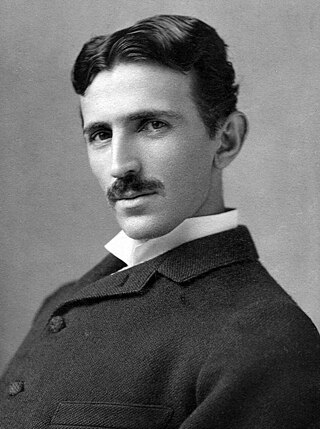
Nikola Tesla was a Serbian-American inventor, electrical engineer, mechanical engineer, and futurist. He is known for his contributions to the design of the modern alternating current (AC) electricity supply system.
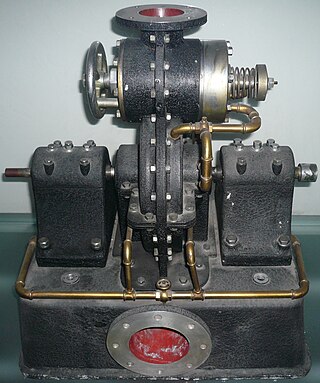
The Tesla turbine is a bladeless centripetal flow turbine invented by Nikola Tesla in 1913. Nozzles apply a moving fluid to the edges of a set of discs. The engine uses smooth discs rotating in a chamber to generate rotational movement due to the momentum exchange between the fluid and the discs. The discs are arranged in an orientation similar to a stack of CDs on a pole.

A Tesla coil is an electrical resonant transformer circuit designed by inventor Nikola Tesla in 1891. It is used to produce high-voltage, low-current, high-frequency alternating-current electricity. Tesla experimented with a number of different configurations consisting of two, or sometimes three, coupled resonant electric circuits.

A crystal oscillator is an electronic oscillator circuit that uses a piezoelectric crystal as a frequency-selective element. The oscillator frequency is often used to keep track of time, as in quartz wristwatches, to provide a stable clock signal for digital integrated circuits, and to stabilize frequencies for radio transmitters and receivers. The most common type of piezoelectric resonator used is a quartz crystal, so oscillator circuits incorporating them became known as crystal oscillators. However, other piezoelectricity materials including polycrystalline ceramics are used in similar circuits.

George Westinghouse Jr. was an American entrepreneur and engineer based in Pennsylvania who created the railway air brake and was a pioneer of the electrical industry, receiving his first patent at the age of 19. Westinghouse saw the potential of using alternating current for electric power distribution in the early 1880s and put all his resources into developing and marketing it. This put Westinghouse's business in direct competition with Thomas Edison, who marketed direct current for electric power distribution. In 1911 Westinghouse received the American Institute of Electrical Engineers's (AIEE) Edison Medal "For meritorious achievement in connection with the development of the alternating current system". He founded the Westinghouse Electric Corporation in 1886.

A tuned mass damper (TMD), also known as a harmonic absorber or seismic damper, is a device mounted in structures to reduce mechanical vibrations, consisting of a mass mounted on one or more damped springs. Its oscillation frequency is tuned to be similar to the resonant frequency of the object it is mounted to, and reduces the object's maximum amplitude while weighing much less than it.

A resonator is a device or system that exhibits resonance or resonant behavior. That is, it naturally oscillates with greater amplitude at some frequencies, called resonant frequencies, than at other frequencies. The oscillations in a resonator can be either electromagnetic or mechanical. Resonators are used to either generate waves of specific frequencies or to select specific frequencies from a signal. Musical instruments use acoustic resonators that produce sound waves of specific tones. Another example is quartz crystals used in electronic devices such as radio transmitters and quartz watches to produce oscillations of very precise frequency.

A jackhammer is a pneumatic or electro-mechanical tool that combines a hammer directly with a chisel. It was invented by William McReavy, who then sold the patent to Charles Brady King. Hand-held jackhammers are generally powered by compressed air, but some are also powered by electric motors. Larger jackhammers, such as rig-mounted hammers used on construction machinery, are usually hydraulically powered. These tools are typically used to break up rock, pavement, and concrete.

An Oudin coil, also called an Oudin oscillator or Oudin resonator, is a resonant transformer circuit that generates very high voltage, high frequency alternating current (AC) electricity at low current levels, used in the obsolete forms of electrotherapy around the turn of the 20th century. It is very similar to the Tesla coil, with the difference being that the Oudin coil was connected as an autotransformer. It was invented in 1893 by French physician Paul Marie Oudin as a modification of physician Jacques Arsene d'Arsonval's electrotherapy equipment and used in medical diathermy therapy as well as quack medicine until perhaps 1940. The high voltage output terminal of the coil was connected to an insulated handheld electrode which produced luminous brush discharges, which were applied to the patient's body to treat various medical conditions in electrotherapy.
The brown note, also sometimes called the brown frequency or brown noise, is a hypothetical infrasonic frequency capable of causing fecal incontinence by creating acoustic resonance in the human bowel. Considered an urban myth, the name is a metonym for the common color of human faeces. Attempts to demonstrate the existence of a "brown note" using sound waves transmitted through the air have failed.

Mechanical resonance is the tendency of a mechanical system to respond at greater amplitude when the frequency of its oscillations matches the system's natural frequency of vibration closer than it does other frequencies. It may cause violent swaying motions and potentially catastrophic failure in improperly constructed structures including bridges, buildings and airplanes. This is a phenomenon known as resonance disaster.
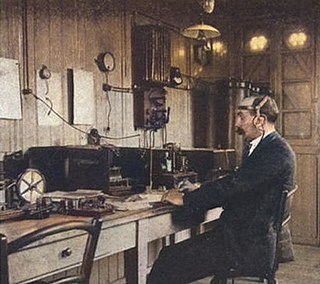
The invention of radio communication was preceded by many decades of establishing theoretical underpinnings, discovery and experimental investigation of radio waves, and engineering and technical developments related to their transmission and detection. These developments allowed Guglielmo Marconi to turn radio waves into a wireless communication system.
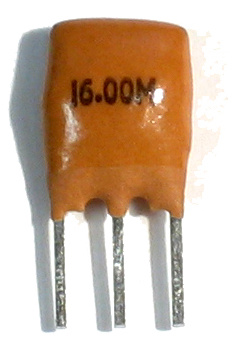
A ceramic resonator is an electronic component consisting of a piece of a piezoelectric ceramic material with two or more metal electrodes attached. When connected in an electronic oscillator circuit, resonant mechanical vibrations in the device generate an oscillating signal of a specific frequency. Like the similar quartz crystal, they are used in oscillators for purposes such as generating the clock signal used to control timing in computers and other digital logic devices, or generating the carrier signal in analog radio transmitters and receivers.
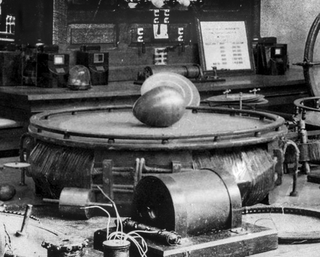
Tesla's Egg of Columbus was a device exhibited in the Westinghouse Electric display at the 1893 Chicago World's Columbian Exposition to explain the rotating magnetic field that drove the new alternating current induction motors designed by inventor Nikola Tesla by using that magnetic field to spin a copper egg on end.
A tectonic weapon is a hypothetical device or system which could trigger earthquakes, volcanic eruptions, or other seismic events in specified locations by interfering with the Earth's natural geological processes. It was defined in 1992 by Aleksey Vsevolodovich Nikolayev, corresponding member of the Russian Academy of Sciences: "A tectonic or seismic weapon would be the use of the accumulated tectonic energy of the Earth's deeper layers to induce a destructive earthquake". He added "to set oneself the objective of inducing an earthquake is extremely doubtful." Though no such device is known to have been built, tectonic weapons have occasionally appeared as plot devices in works of fiction.
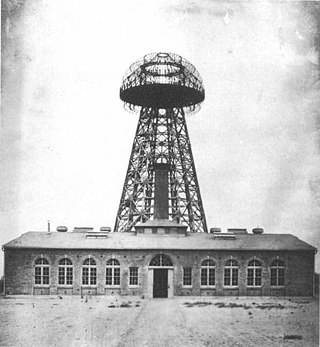
The World Wireless System was a turn of the 20th century proposed telecommunications and electrical power delivery system designed by inventor Nikola Tesla based on his theories of using Earth and its atmosphere as electrical conductors. He claimed this system would allow for "the transmission of electric energy without wires" on a global scale as well as point-to-point wireless telecommunications and broadcasting. He made public statements citing two related methods to accomplish this from the mid-1890s on. By the end of 1900 he had convinced banker J. P. Morgan to finance construction of a wireless station based on his ideas intended to transmit messages across the Atlantic to England and to ships at sea. His decision to change the design to include wireless power transmission to better compete with Guglielmo Marconi's new radio based telegraph system was met with Morgan's refusal to fund the changes. The project was abandoned in 1906, never to become operational.

Nikola Tesla patented the Tesla coil circuit on April 25, 1891. and first publicly demonstrated it May 20, 1891 in his lecture "Experiments with Alternate Currents of Very High Frequency and Their Application to Methods of Artificial Illumination" before the American Institute of Electrical Engineers at Columbia College, New York. Although Tesla patented many similar circuits during this period, this was the first that contained all the elements of the Tesla coil: high voltage primary transformer, capacitor, spark gap, and air core "oscillation transformer".
















